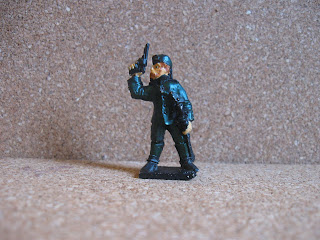 |
| British Infantryman, Anglo-Zulu War, c.1879 - don't know the source as I found it on Pinterest and can't read the signature, sorry. It may say 'Girard '69'. It may not. |
Anyway, the majority of my British Infantry look something like this (but with white Pith Helmets, and also blue rather than green cuffs, as they're the 'Royal North Surrey Regiment', and 'royal' regiments had blue cuffs). Had the two sets of arms been compatible sizes I'd have maybe had to scratch off the cuff detailing for the cavalry, and paint something suitable for the infantry - but it was not to be, the arms were too different in scale.
So, back to the cavalry. I gave them red jackets and painted a white band around their cuffs - what I think are referred to as 'jampot' cuffs. I painted the troopers' helmets khaki and left the officer's white. Though the uniforms are ahistorical I don't really care - they're close enough for my purposes as generic 'British' cavalry of the broad period 1870-1885.
I have an Officer (white hat and sword), I painted a Sergeant's stripes on the arms of a chap with a pistol, I gave one a bugle and another a staff for some kind of unit flag (these last two options are included on every frame). There are 6 regular troopers here, most with unsheathed swords, but one with a pistol.
At the back are two chaps who don't, as yet, have right arms. What I'd like to do is give these two VSF-y weapons - preferably, something that can be used as a lightning gun or galvanic projector (or what might be called, in a sci-fi context, a 'laser-rifle'). My plan at the moment is to use the two spare arms for holding the unused banner-poles. These are open-handed right arms supplied one per frame.
The two chaps who will hold the Lightning Guns, to my broken old eyes anyway, somewhat resemble Christopher Plummer and Sean Connery.
 |
| Two of the cavalrymen, destined for life as Galvanic Dragoons, probably. Sorry about the terrible picture, I'll try to get a better one... |
This I think will be enough to give the unit a bit of VSF clout, but also allow me to field 10 perfectly normal British cavalry if necessary. However, what I don't yet have is the Lightning Guns. I shall have to try to bodge something together as I did with my UNIT force (whose Sergeant Benton carries a peculiar device constructed from bits of sprue). However if I can find a source for something suitably laser-rifle-y, perhaps I can use that instead.
Of course I also need to fix up the flag for the flagpole. Maybe it's time to flesh out the early history (and iconography) of (Prince Rupert's Own) 43rd Regiment of Horse...
Of course I also need to fix up the flag for the flagpole. Maybe it's time to flesh out the early history (and iconography) of (Prince Rupert's Own) 43rd Regiment of Horse...
Whoever I decide these chaps are, I guess I'll be statting them up for GASLIGHT and IHMN.













 Whimsy's family tree
Whimsy's family tree






